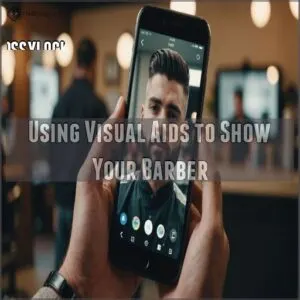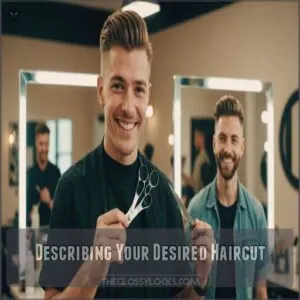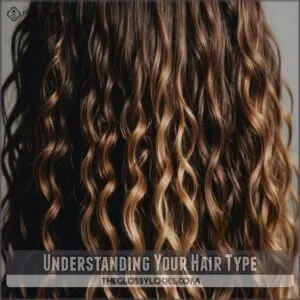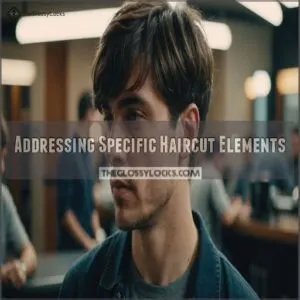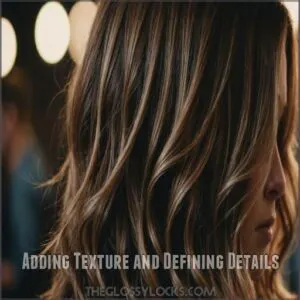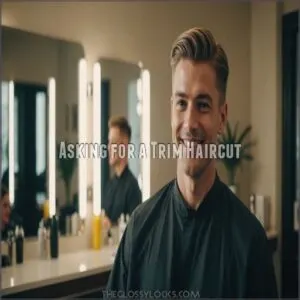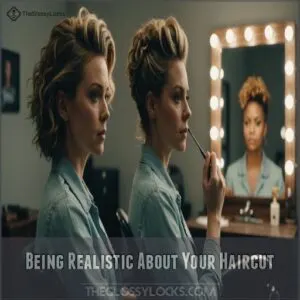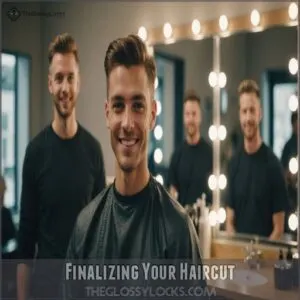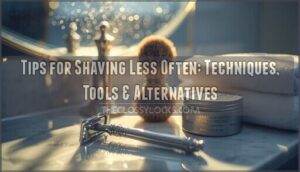This site is supported by our readers. We may earn a commission, at no cost to you, if you purchase through links.
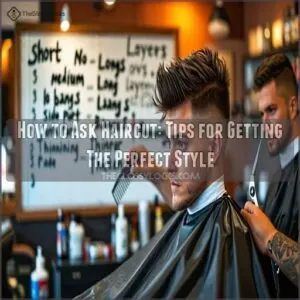
Bring clear, specific descriptions to your chair—think about length, layers, and that elusive swish of bangs.
Pictures speak volumes, so gather inspiration from Instagram or Pinterest.
Talk openly, and don’t hesitate to dish on past hair disasters.
Let your barber’s expertise guide your choices—they know what suits your hair type like a favorite old sweater knows your shape.
Be ready for an enlightening chat about maintaining your new style, because that’s where the magic of a great haircut truly begins.
Table Of Contents
- Key Takeaways
- Cultivating a Relationship
- Preparing for Your Haircut
- Describing Your Desired Haircut
- Understanding Your Hair Type
- Addressing Specific Haircut Elements
- Adding Texture and Defining Details
- Asking for a Trim Haircut
- Getting The Expert’s Opinion
- Being Realistic About Your Haircut
- Finalizing Your Haircut
- Frequently Asked Questions (FAQs)
- How to ask for a haircut?
- Can you get a haircut from a barber?
- How do you talk to a barber about a haircut?
- How do I get a good haircut?
- What do I say when asking for a haircut?
- How do I ask my hairdresser for a haircut?
- How do I ask for a trim haircut?
- How do I describe what haircut I want?
- How do I find a good barber nearby?
- What if I cant find reference photos?
- How often should I get a haircut?
- Can my haircut enhance facial features?
- What questions should I ask before my cut?
- Conclusion
Key Takeaways
- Bring clear reference photos to your barber and be specific about length, layers, and style details you want – visual aids help avoid miscommunication and ensure you get the results you’re seeking.
- Understand your hair type and its limitations – what works for straight hair won’t necessarily work for curly hair, so focus on styles that complement your natural texture and thickness.
- Build trust with your barber through open communication – share your past experiences, listen to their expert advice, and don’t hesitate to speak up if something doesn’t feel right during the cut.
- Check the final results carefully before leaving the chair – examine the overall shape, length, and details in different lighting, and politely request adjustments if needed to ensure you’re completely satisfied.
Cultivating a Relationship
To get the haircut you truly want, start by finding the right barber who understands your style.
Building a strong relationship means having open communication and trusting their expertise.
Turning each visit into a rewarding experience.
Finding The Right Barber
Finding the right barber feels like finding a needle in a haystack, but it’s not impossible.
Start with barber recommendations from friends or family, then check online reviews.
Visit local barber shops for trial cuts; these give you a feel for their style.
Building trust is key, so discuss your haircut expectations and face shape during your haircut consultation.
Get reliable haircut advice along the way.
Building Open Communication
Open communication with your barber helps you get the style you envision.
To cultivate this, focus on:
- Barber Communication: Use clear, specific terms to express your desired haircut.
- Client Honesty: Be honest about past haircut experiences and preferences.
- Shared Language: Align your terminology with your barber’s understanding.
- Active Listening: Pay attention to feedback on hair type, texture, and product usage.
Trusting Your Barber’s Expertise
Great communication’s key; listen to your barber’s suggestions. They’ve seen it all, know what works with your hair type. Respect their expertise; they offer valuable hair type advice.
Honesty about styles is essential. Don’t be afraid to ask questions. A good barber will help you find the perfect style, whether it’s a french crop or burst fade.
Building this relationship means you’ll always leave looking and feeling your best. Remember, great hair care starts with open communication and trust.
Preparing for Your Haircut
Before heading to the salon, gather a few reference pictures that capture the style you’re aiming for, as this will help bridge any communication gaps.
Visual aids, like photos from Instagram or magazines, can effectively convey your ideas to your barber, ensuring you leave with the look you love.
Gathering Reference Pictures
Before stepping into your stylist’s chair, make sure you’ve collected a gallery of hairstyle snapshots.
These images can be your map to finding inspiration and guiding your barber to understand your vision.
Instagram and Pinterest are treasure troves for saving images of sleek cuts, subtle fades, and daring styles.
But beware, not all images suit every hair type.
Use filters to find examples that match your texture and length.
Sharing references with your barber helps avoid bad examples and unnecessary surprises.
This prep work ensures a haircut that aligns with your unique style aspirations.
Using Visual Aids to Show Your Barber
From gathering reference pictures, you’ve got a shortcut to visual communication with your barber.
Swipe through Instagram or pin on Pinterest to find your dream look.
Hairstyle apps can be your personal style assistant, showcasing various cuts.
You can also find inspiration by browsing websites like haircut picture websites that offer a wide range of styles.
Don’t just say "a bit shorter"—show them!
Reference photos speak volumes when words fail.
Imagine this: your barber sees the angles, the texture, the vibe you’re vibing with.
It’s like handing them a map to your hair goals.
You’re not just getting a haircut; you’re crafting a masterpiece, one snip at a time.
Describing Your Desired Haircut
When describing your desired haircut to your barber, it’s essential to be clear and specific about the style you want.
Use descriptive language to communicate the overall effect you’re aiming for.
Don’t be shy about expressing your preferences—after all, it’s your hair that will do all the talking afterwards!
Being Clear and Specific About Style
As you gather reference pictures, remember that being clear about your desired look is key.
Think about specific details—length, layers, bangs.
Do you have favorite visual references? Bring them along.
Consider your hair type; it can make a world of difference.
Use haircut vocabulary your barber understands.
With the right words, you’re headed for a style you love.
Using Descriptive Language to Communicate
Feeling uncertain in the barber’s chair?
Grab those communication tips and describe your dream haircut using descriptive language, including specific terms like "layers" or "blunt cuts" to help you and your barber get on the same page.
Chat about hair texture and the feeling you want when you look in the mirror.
Toss in visual references, like photos from your favorite social media.
Clear words bridge you and your barber, crafting a style you’ll love without leaving room for disappointment.
Focusing on Overall Effect
Instead of focusing on tiny details, picture your desired look as a whole.
Think about your overall style vibe.
To help your barber understand, bring:
- A mood board.
- Visual inspiration.
- Examples of your hair goals.
This helps them grasp your vision, leading to a fantastic haircut that matches your Style Vibe.
Understanding Your Hair Type
Understanding your hair type is like owning the user’s manual to your hairstyle destiny; it helps you know what cuts will work best for your unique texture and thickness.
Don’t hesitate to ask your barber for guidance—they’re your best resource for turning that manual into a style you’re proud of.
Knowing Your Hair Texture and Thickness
Imagine this: you’ve finally described the perfect haircut, but does your hair want to cooperate?
Knowing your hair texture and thickness holds the key.
Curly, wavy, or straight, each type has a unique vibe.
Here’s a quick guide:
| Hair Type | Best Care Tip |
|---|---|
| Curly | Hydrate regularly |
| Wavy | Use light products |
| Straight | Avoid heavy styling |
| Thick | Thin strategically |
Understanding your hair is like reading its diary!
Understanding How Hair Type Affects Cuts
Your hair type is like a secret ingredient; it spices up your cut, pushing boundaries or showing limitations.
Picking the right style that suits your hair’s texture and thickness can save headaches down the line.
A fresh haircut can make a huge difference in our overall appearance and confidence, similar to how a haircut can change your life.
Consider these tips:
- Texture impact: Wavy, curly determines your styling routine.
- Hair thickness: Thicker hair often requires strategic thinning.
- Maintenance needs: Choose easy-to-manage styles.
Asking Your Barber for Hair Type Guidance
Every head of hair tells its own story, influencing how cuts actually look.
It’s pivotal to know your hair type, texture, and thickness before sitting in the chair.
This chat with your barber becomes essential.
Ask for advice on styles that suit your hair’s unique needs and maintenance.
Here’s a handy guide:
| Hair Type | Texture | Maintenance |
|---|---|---|
| Straight | Smooth | Low |
| Wavy | Curvy | Medium |
| Curly | Dense | High |
| Coily | Tight | Very High |
| Fine | Thin | Low |
Addressing Specific Haircut Elements
When you’re ready to discuss the specifics of your haircut, start by clearly describing the general style and precise length you envision.
Don’t forget to communicate your taper and neckline preferences clearly to avoid any surprise results.
Describing General Style and Length
Regarding your haircut, clarity is king.
Clearly describe the general style and hair length you’re after by using phrases like “an inch off the top” for guidance.
Whether you’re aiming for a crisp fade or a softer overall shape, being precise helps your barber align with your desired look, ensuring you leave satisfied.
Communicating Taper Preferences
Now that you’ve decided on the overall length, let’s talk tapers.
Do you want a short, medium, or long taper?
Think about the Taper Length and Taper Shape you prefer, considering styles like the Low Fade for Oval Faces.
Pictures help!
A Taper vs. Fade is a key difference; tapers blend gradually without shaved skin.
Explain your vision clearly to your barber, using terms like "high taper" or "low taper."
Many Taper Styles exist; find one that suits you!
Choosing a Neckline Option
You’ve established your taper preferences; next, let’s tackle neckline styles.
Deciding between a blocked vs. rounded look or even a tapered neckline can shape your style.
A blocked neckline provides a clean, squared finish, while a rounded one softens the edges.
If natural is more your speed, a tapered neckline subtly follows your neck’s contours.
Specifying Measurements and Adjustments
Moving from neckline options to the nuances of specifying measurements is like choosing between ice cream flavors—details matter.
Tell your barber exactly how much hair to snip by discussing hair length, whether you fancy a fade or taper, and your sideburn length.
A bit of humor helps, too!
- Hair length: "An inch off the top."
- Fade vs. Taper: “Subtle blend, please.”
- Sideburn length: “Just to mid-ear.”
Adding Texture and Defining Details
When you’re looking to add texture or define details in your haircut, communicate exactly what you want with terms like "choppy" or "razored."
Understanding techniques like point cutting or layering helps you achieve the perfect balance of volume and definition, making your haircut uniquely yours.
Communicating Desired Texture and Style
Express your desired hair texture and style to your barber with clarity.
You might ask for choppy layers or sleek, smooth finishes using specific style terminology.
Share visual references to guide the conversation and help your barber understand your desired look.
A little humor and light-heartedness can ease the process, ensuring open and effective barber communication.
| Style | Term | Visual Reference |
|---|---|---|
| Choppy | Layers | Picture 1 |
| Sleek | Smooth | Picture 2 |
| Textured | Tousled | Picture 3 |
Understanding Point Cutting and Razoring
Understanding texture and style involves grasping point cutting and razoring. These techniques shape your look beyond basic trims. Point cutting adds texture, perfect for blending harsh lines. Razoring benefits those seeking smooth edges and less bulk. Consider your hair type and texture when choosing.
Here’s a quick snapshot:
- Point Cutting Techniques
- Razoring Benefits
- Texture and Style Enhancements
- Hair Type Considerations
Adding Volume With Layering
Layered styles are your ticket to a volume boost when your hair feels limp.
Layered haircuts create movement by placing longer sections over shorter ones, enhancing hair texture and density.
Want to rock a bouncier look?
| Layer | Volume Boost |
|---|---|
| Top | High |
| Upper | Moderate |
| Mid | Balanced |
| Lower | Subtle |
| Ends | Light |
Reducing Volume With Thinning
Got thick hair and need some volume control?
Thinning shears are your new best friend, especially when considering styles like a Textured Crop with Fade.
These specialized scissors help reduce bulk without sacrificing length.
It’s perfect for managing hair density and achieving a more manageable style.
Discuss your hair type and desired results with your stylist.
They can help you achieve the perfect balance between volume and texture.
Remember, thinning shears are a great tool for achieving the perfect look.
Defining Arches and Sideburns
Imagine this: your haircut’s secret weapons are arches and sideburns. To finesse them, consider these tips:
- High vs. Natural Arches: Decide if a sleek high arch or a subtle natural one suits you.
- Sideburn Styles: Opt for fades or classic lengths.
- Arch Maintenance: Keep them tidy to highlight your face.
- For a more polished look, explore mens haircut products at mens haircut tools.
Your style, your rules!
Asking for a Trim Haircut
When asking for a trim haircut, it’s important to specify exactly how much length you want taken off, like saying "just half an inch."
Think of the trim as a refresh for your style, ensuring you leave the chair looking neat without any drastic changes.
Specifying Length and Style
Tweaking your style, while keeping the length just right, can feel like walking a tightrope.
You know where the hairline should end, but what about the top length or side length?
A handy tip: Fade vs Taper is key—each offers its own flair.
Here’s a little chart to help:
| Feature | Option 1 | Option 2 |
|---|---|---|
| Hairline | Natural | Defined |
| Top Length | Short | Medium |
| Side Length | Taper | Fade |
Don’t forget clipper settings matter.
Channel your inner stylist and express exactly what you want.
Describing The Overall Trim
As you specify the length and style, don’t forget to address the overall trim, which is as important as choosing a flashy car or comfy shoes.
Talk about the trim length clearly with your barber, mentioning whether you prefer a fade or a taper.
These choices shape your haircut’s final look.
Considering the hairline shape and overall volume can make a huge difference too.
Want a textured finish? Mention it!
The specifics of your trim are like the brushstrokes in a painting, adding up to craft the perfect style.
Getting The Expert’s Opinion
When you’re unsure about your next look, don’t hesitate to ask your barber for suggestions; their expertise can guide you to a style that suits your hair type and lifestyle.
Trust your barber’s input—after all, they’re the professionals who see your potential, even when you can’t.
Asking for Suggestions and Guidance
Sometimes, knowing what you want isn’t enough; asking for guidance is where the magic happens.
Here’s how to leverage your barber’s skills.
- Ask for a Barber Recommendation: This opens avenues for style exploration you hadn’t considered.
- Discuss Your Hair Type: Get hair type advice to tailor your look, ensuring it flatters you.
- Seek Feedback and Ideas: Your barber’s insights are gold.
Use consultation tips to gain a fresh perspective on your style vision.
Engage with your barber; don’t be shy.
They might just have the perfect tweak for you!
Considering Your Barber’s Expertise
Before you even sit down, remember that your barber’s expertise is invaluable.
They’ve seen it all—from fantastic fades to unfortunate fringe disasters.
Lean on their experience!
Ask for their opinion; they might suggest a style that better suits your hair type and lifestyle.
Good communication is key.
| Question | Answer |
|---|---|
| Hair type? | Fine, thick, curly, straight, etc. |
| Lifestyle? | Active, low-maintenance, formal, etc. |
| Face shape? | Round, oval, square, etc. |
| Maintenance commitment? | High, medium, or low |
Trusting your barber’s professional advice can lead to a killer haircut.
They’ll offer Barber recommendations, and share stylist experience, giving you the confidence to achieve your dream look.
Open communication is essential for getting the perfect style; don’t hesitate to ask questions.
Being Realistic About Your Haircut
When dreaming of your next haircut, it’s key to recognize your hair’s natural limitations and avoid chasing unrealistic expectations.
Focus on styles that work with your unique hair type to guarantee a satisfying and achievable result.
Understanding Hair Limitations
Embrace your natural hair’s quirks and celebrate its uniqueness!
Standing out involves understanding the hair growth cycle and how hair type limitations play into style choices.
Realistic expectations are key—remember, you can’t force curls to fall straight or thin strands to thicken magically.
To get the perfect style, consider your hair type and whether you should get a dry cut for precision curl treatment. Experiment with hair styling products to elevate your look, keeping hair texture impact in mind for achievable perfection.
Avoiding Unrealistic Expectations
Grasp the essence of hair type limitations and realistic hair goals.
Expecting your curls to mirror a sleek bob might clash with reality, given natural texture and hair growth rate differences.
Consider maintenance time: it influences style viability.
Chat openly with your stylist about style limitations, and don’t hesitate to ask for insights.
It’s about working with, not against, what you’ve got.
Focusing on Achievable Styles
Let’s be honest—some styles just won’t suit your hair type.
Recognize your hair limitations and lean into realistic expectations.
Use style inspiration wisely, steering clear of fleeting trends that demand too much maintenance.
Instead, commit to a look that complements you effortlessly.
Sometimes, a small tweak makes all the difference, proving that less can indeed be more with the right choices.
Finalizing Your Haircut
Before you leave the chair, double-check the details to make sure your haircut matches your vision.
Confirm you’re satisfied with the outcome, and if anything feels off, don’t hesitate to speak up—it’s your hair, after all!
Confirming Your Haircut Details
You’ve got your eye on a new style, but remember to confirm those haircut details before the scissors start snipping.
Checking out popular haircut styles online can also help you better communicate your vision to your barber.
Popular haircut styles can give you inspiration and ideas to discuss with your barber.
While envisioning your desired look, take a moment to clarify the hairline, length, taper, texture, and finish with your barber.
These elements are essential for achieving the hairstyle you want.
It’s like ensuring your coffee order is precise – nobody wants surprises!
A little chat with your barber can go a long way.
Ensuring everyone’s on the same page keeps you in control and feeling fabulous once you leave the chair.
Ensuring You’re Happy With The Result
Before you leave the barber’s chair, take a moment to really look at your new haircut.
Does it meet your expectations?
Open communication is key; don’t hesitate to voice any concerns.
Remember, your feedback helps your barber improve.
Trust your gut; if something feels off, politely ask for adjustments.
If your haircut doesn’t turn out as expected, consider fixing a bad short haircut to achieve the look you want.
Here’s what you should do:
- Check the overall shape and style.
Does it flatter your face and hair type?
- Examine the details, like the length and texture.
Are they as you envisioned?
- Look at it in different lighting to check for evenness.
- If you’re happy, great! If not, gently communicate your concerns.
A good barber will want to make sure you’re thrilled with the final result.
Frequently Asked Questions (FAQs)
How to ask for a haircut?
Over 70% of bad haircuts result from miscommunication!
Bring reference photos, and clearly describe your desired style.
Ask your barber about hair type suitability and be open to their suggestions.
Communication makes sure you leave with confidence.
Can you get a haircut from a barber?
Getting a haircut from a barber is a breeze.
Just pop in, share your style preferences clearly, and let the barber work their magic.
It’s all about that open communication to achieve the look you desire!
How do you talk to a barber about a haircut?
In bygone days, you’d face the barber with clarity.
Start with specific terms and visuals like photos.
Express preferences and concerns comfortably.
Your barber’s expertise should guide adjustments, ensuring your haircut complements your unique style and hair type.
How do I get a good haircut?
Nail a good haircut by showing your barber reference photos and describing your desired style clearly.
Know your hair type and be open to your barber’s suggestions.
Build trust through communication and don’t hesitate to express concerns.
What do I say when asking for a haircut?
Ironically, a bad haircut’s a common fear.
Bring reference photos!
Clearly describe your desired style and length.
Communicate your hair type and desired texture.
Trust your barber’s expertise, but don’t be afraid to speak up.
How do I ask my hairdresser for a haircut?
Bring reference pictures and describe your desired style clearly.
Use specific terms like "an inch off the top" or "tapered neckline."
Be open to your hairdresser’s suggestions, and don’t hesitate to ask questions.
Communication is key for your perfect cut.
How do I ask for a trim haircut?
To ask for a trim, be clear and specific.
Show, tell, and measure: use photos, describe your desired look, and indicate how much to cut.
Trust your barber’s expertise, but don’t hesitate to voice your preferences or concerns.
How do I describe what haircut I want?
Describe your desired haircut using clear, specific terms and visual references.
Show your barber pictures of styles you like, explaining which elements you want.
Discuss length, texture, and details like tapering or layering.
Be open to their expert suggestions.
How do I find a good barber nearby?
Did you know 85% of people trust online reviews?
You’ll find a great barber by checking local ratings, asking friends for recommendations, and visiting shops to assess cleanliness and vibe.
Trust your gut and don’t be afraid to try someone new!
What if I cant find reference photos?
Don’t sweat it if you can’t find photos.
Describe your ideal look using everyday terms.
Focus on length, texture, and overall style.
You might say, "I want a shaggy, medium-length cut that’s easy to style."
Your barber will guide you.
How often should I get a haircut?
Picture your hair as a garden; it needs regular pruning.
You’ll typically need a trim every 4-6 weeks.
But it’s not set in stone – your hair type, style, and growth rate play a part.
Listen to your locks!
Can my haircut enhance facial features?
Your haircut can accentuate your best features.
The right style can highlight your cheekbones, soften a strong jaw, or elongate your face.
Work with your barber to choose a cut that complements your unique facial structure.
What questions should I ask before my cut?
For oblong faces, consider adding volume on top with a textured crop hairstyle. Ask your barber about recommended styles for your face shape and hair type.
Inquire about maintenance, products, and how often you’ll need trims.
Don’t forget to discuss any cowlicks or specific concerns you have.
Communication’s key for a great cut!
Conclusion
Like Samson’s legendary locks, your hair holds power—the power to boost confidence and shape your image.
Armed with these tips on how to ask for a haircut, you’re ready to conquer the barber’s chair.
Remember, clear communication is key.
Bring photos, describe your vision, and trust your barber’s expertise.
Don’t shy away from asking questions or seeking advice.
With practice, you’ll master the art of articulating your perfect style.
So go forth, embrace the scissors, and let your hair do the talking.



